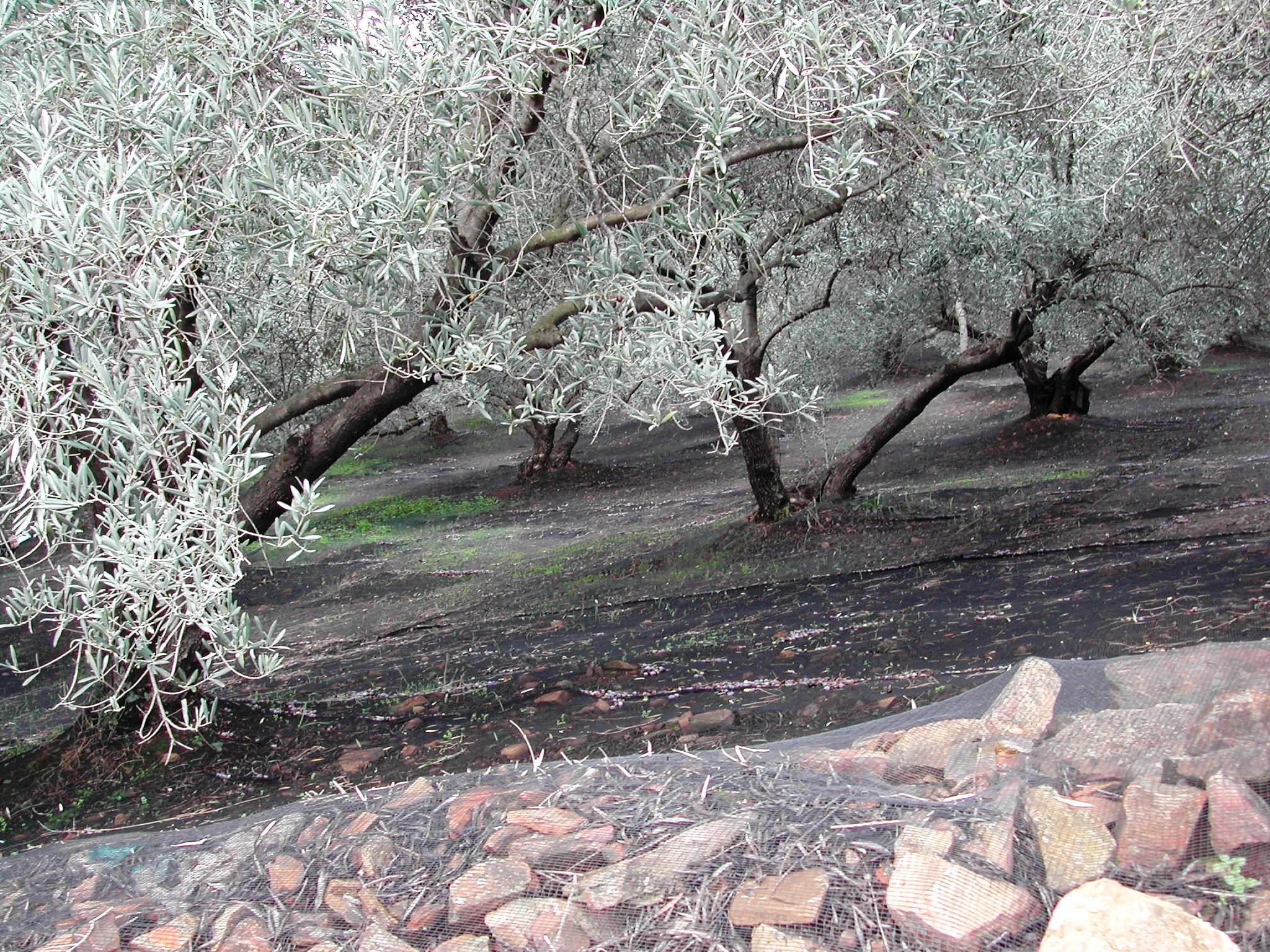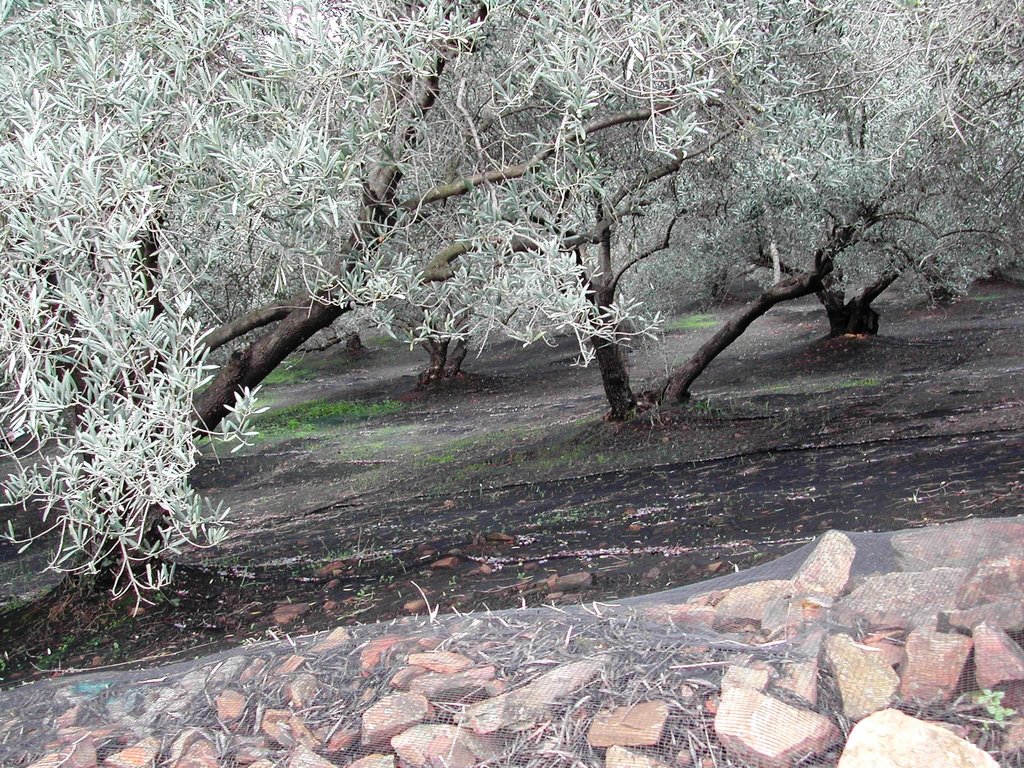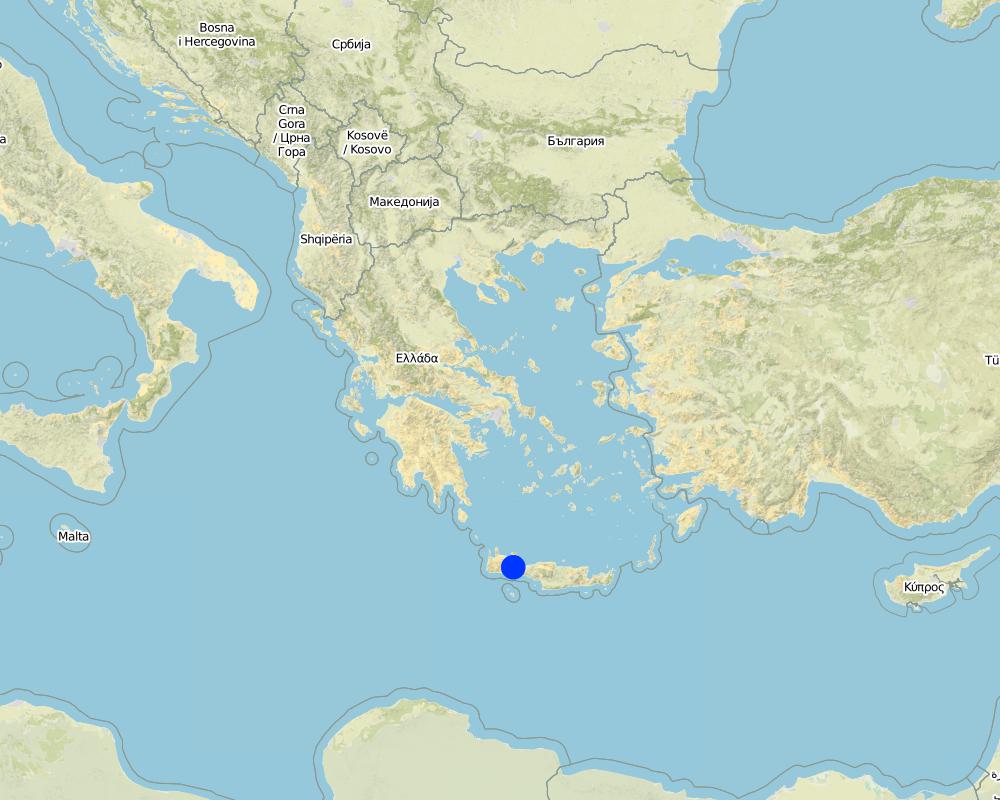No tillage operations, plastic nets permanently on the soil surface [希腊]
- 创建:
- 更新:
- 编制者: Costas Kosmas
- 编辑者: –
- 审查者: Fabian Ottiger, Alexandra Gavilano
Κάλυψη με πλαστικά (Greek)
technologies_1087 - 希腊
查看章节
全部展开 全部收起1. 一般信息
1.2 参与该技术评估和文件编制的资源人员和机构的联系方式
SLM专业人员:
Mentzidakis Ioannis
National Agricultural Research Foundation - NAGREF - Institute of Olive
希腊
有助于对技术进行记录/评估的机构名称(如相关)
Agricultural University of Athens (AUAb) - 希腊有助于对技术进行记录/评估的机构名称(如相关)
National Agricultural Research Foundation (NAGREF) - 希腊1.3 关于使用通过WOCAT记录的数据的条件
编制者和关键资源人员接受有关使用通过WOCAT记录数据的条件。:
是
2. SLM技术的说明
2.1 技术简介
技术定义:
A technology which combines no tillage operations and the cover of the ground with plastic nets
2.2 技术的详细说明
说明:
This technology has the same main advantages and characteristics as no tillage operation against soil erosion and water lconservation. Soil erosion is drastically reduced since soil surface is protected from raindrop splashing by the existing annual vegetation and the plastic nets. Soil water evaporation is also reduced due to the mulching provided by the plant residues and the nets. Furthermore, higher amount of rain water is infiltrating into the soil compared with other traditional LMPs. The specific technique has emerged as a need to overcome obstacles to the collection of olive fruits and protection of the nets from animals. Nets are spread in the whole field (intensive cultivation) covering completely the soil surface or part of the field (extensive cultivation), so olive fruits falling down can be periodocally collected by the farmer. Furthermore, a problem arises if nets are removed from the ground and stored. Animals, like mice, prefer to go in and make their nets by destroying them. Therefore, by keeping nets in the field during the whole year they are protected from such damages. Nets are installed in the field by stones or using metallic pins of about 15 cm long which are entered into the soil. Nets can remain in the field at least 10 years. Referring to the map showing areas undergoing tillage and non-tillage operations in the study area of Chania, it can be noted that the combined technique using cover nets is applied mainly in areas with high altitude and at a rate of approximately 15% of the no tillage area.
2.3 技术照片
2.5 已应用该技术的、本评估所涵盖的国家/地区/地点
国家:
希腊
区域/州/省:
Kissamos province
有关地点的进一步说明:
Chania-Crete
注释:
Total area covered by the SLM Technology is 5 km2.
Map
×3. SLM技术的分类
3.2 应用该技术的当前土地利用类型

农田
- 乔木与灌木的种植
乔木和灌木种植 - 指定作物:
- 橄榄树
具体说明:
Longest growing period in days: 120Longest growing period from month to month: March to JuneSecond longest growing period in days: 150Second longest growing period from month to month: March to June
注释:
Major land use problems (compiler’s opinion): high soil erosion rates and lack of water for irrigation
Major land use problems (land users’ perception): Hig cost of olive oil production
3.4 供水
注释:
Water supply: mixed rainfed - irrigated, full irrigation
3.5 该技术所属的SLM组
- 改良的地面/植被覆盖
- 最小的土壤扰动
3.6 包含该技术的可持续土地管理措施

农艺措施
- A3:土壤表面处理

管理措施
- M2:改变管理/强度级别
注释:
Main measures: agronomic measures
Secondary measures: management measures
Type of agronomic measures: retaining more vegetation cover, mulching, manure / compost / residues, zero tillage / no-till
Type of vegetative measures: in blocks
3.7 该技术强调的主要土地退化类型

土壤水蚀
- Wt:表土流失/地表侵蚀

水质恶化
- Hs:地表水良变化
注释:
Main type of degradation addressed: Wt: loss of topsoil / surface erosion
Secondary types of degradation addressed: Hs: change in quantity of surface water
Main causes of degradation: crop management (annual, perennial, tree/shrub) (soil erosion), poverty / wealth (loss in farm income)
3.8 防止、减少或恢复土地退化
具体数量名该技术与土地退化有关的目标:
- 减少土地退化
注释:
Main goals: mitigation / reduction of land degradation
4. 技术规范、实施活动、投入和成本
4.1 该技术的技术图纸
技术规范(与技术图纸相关):
Technical knowledge required for land users: low
Main technical functions: increase in organic matter
Secondary technical functions: increase of surface roughness
Retaining more vegetation cover
Material/ species: oxalis sp
Mulching
Material/ species: plastics
Quantity/ density: plastics a
Manure / compost / residues
Material/ species: green manure, oxalis sp
Remarks: natural growing plant
Zero tillage / no-till
Remarks: tillage is not allowed since nets will be destroyed
In blocks
Vegetative material: O : other
Number of plants per (ha): 250
Vertical interval between rows / strips / blocks (m): 5
Spacing between rows / strips / blocks (m): 5
Vertical interval within rows / strips / blocks (m): 5
Width within rows / strips / blocks (m): 4
Perennial crops species: olives
Other species: existing vegetation
4.2 有关投入和成本计算的一般信息
其它/国家货币(具体说明):
Euro
如相关,注明美元与当地货币的汇率(例如1美元=79.9巴西雷亚尔):1美元=:
1.49
注明雇用劳工的每日平均工资成本:
80.00
4.3 技术建立活动
| 活动 | 时间(季度) | |
|---|---|---|
| 1. | Buy the nets |
4.4 技术建立所需要的费用和投入
| 对投入进行具体说明 | 单位 | 数量 | 单位成本 | 每项投入的总成本 | 土地使用者承担的成本% | |
|---|---|---|---|---|---|---|
| 劳动力 | Installation | ha | 1.0 | 320.0 | 320.0 | |
| 设备 | Nets | ha | 1.0 | 2700.0 | 2700.0 | |
| 技术建立所需总成本 | 3020.0 | |||||
| 技术建立总成本,美元 | 2026.85 | |||||
注释:
Duration of establishment phase: 0.1 month(s)
4.5 维护/经常性活动
| 活动 | 时间/频率 | |
|---|---|---|
| 1. | replacing destroyed nets | 0.2 days/ha/year |
| 2. | reinstalling nets removed by winds or other reason | 0.5 days/ha/year |
4.6 维护/经常性活动所需要的费用和投入(每年)
注释:
Machinery/ tools: no tools
the cost has been calculated for the year 2009
4.7 影响成本的最重要因素
描述影响成本的最决定性因素:
the purchase of materials
5. 自然和人文环境
5.1 气候
年降雨量
- < 250毫米
- 251-500毫米
- 501-750毫米
- 751-1,000毫米
- 1,001-1,500毫米
- 1,501-2,000毫米
- 2,001-3,000毫米
- 3,001-4,000毫米
- > 4,000毫米
有关降雨的规范/注释:
With 6 months of dry period
农业气候带
- 半干旱
Thermal climate class: temperate
5.2 地形
平均坡度:
- 水平(0-2%)
- 缓降(3-5%)
- 平缓(6-10%)
- 滚坡(11-15%)
- 崎岖(16-30%)
- 陡峭(31-60%)
- 非常陡峭(>60%)
地形:
- 高原/平原
- 山脊
- 山坡
- 山地斜坡
- 麓坡
- 谷底
垂直分布带:
- 0-100 m a.s.l.
- 101-500 m a.s.l.
- 501-1,000 m a.s.l.
- 1,001-1,500 m a.s.l.
- 1,501-2,000 m a.s.l.
- 2,001-2,500 m a.s.l.
- 2,501-3,000 m a.s.l.
- 3,001-4,000 m a.s.l.
- > 4,000 m a.s.l.
5.3 土壤
平均土层深度:
- 非常浅(0-20厘米)
- 浅(21-50厘米)
- 中等深度(51-80厘米)
- 深(81-120厘米)
- 非常深(> 120厘米)
土壤质地(表土):
- 中粒(壤土、粉土)
表土有机质:
- 高(>3%)
5.4 水资源可用性和质量
地下水位表:
> 50米
地表水的可用性:
好
关于水质和水量的注释和进一步规范:
Water quality (untreated): good drinking water, for agricultural use only (irrigation)
5.5 生物多样性
物种多样性:
- 高
5.6 应用该技术的土地使用者的特征
生产系统的市场定位:
- 生计(自给)
- 混合(生计/商业)
非农收入:
- 低于全部收入的10%
相对财富水平:
- 平均水平
- 丰富
个人或集体:
- 个人/家庭
机械化水平:
- 手工作业
- 机械化/电动
性别:
- 男人
说明土地使用者的其他有关特征:
Land users applying the Technology are mainly common / average land users
Difference in the involvement of women and men: Yes women are used to work mainly in the house
Population density: 10-50 persons/km2
Annual population growth: 1% - 2%
5% of the land users are rich.
55% of the land users are average wealthy.
5.7 应用该技术的土地使用者使用的平均土地面积
- < 0.5 公顷
- 0.5-1 公顷
- 1-2 公顷
- 2-5公顷
- 5-15公顷
- 15-50公顷
- 50-100公顷
- 100-500公顷
- 500-1,000公顷
- 1,000-10,000公顷
- > 10,000公顷
这被认为是小规模、中规模还是大规模的(参照当地实际情况)?:
- 小规模的
注释:
Average area of land owned or leased by land users applying the Technology: 2-5 ha, 5-15 ha, 15-50 ha
5.8 土地所有权、土地使用权和水使用权
土地所有权:
- 个人,有命名
土地使用权:
- 社区(有组织)
- 个人
用水权:
- 社区(有组织)
- 个人
5.9 进入服务和基础设施的通道
技术援助:
- 贫瘠
- 适度的
- 好
市场:
- 贫瘠
- 适度的
- 好
金融服务:
- 贫瘠
- 适度的
- 好
6. 影响和结论性说明
6.1 该技术的现场影响
社会经济效应
生产
土地管理
注释/具体说明:
Problem if a minimum tillage LMP is applied since nets must be removed
收入和成本
农业收入
SLM之前的数量:
1800 Euro/ha
SLM之后的数量:
3200 Euro/ha
工作量
社会文化影响
SLM/土地退化知识
Improved livelihoods and human well-being
注释/具体说明:
Increase in farmers income and reduction the off-site effects
生态影响
水循环/径流
水质
地表径流
土壤
土壤水分
土壤流失
土壤结壳/密封
土壤压实
6.2 该技术的场外影响已经显现
下游洪水
地下水/河流污染
6.3 技术对渐变气候以及与气候相关的极端情况/灾害的暴露和敏感性(土地使用者认为的极端情况/灾害)
气候有关的极端情况(灾害)
气候灾害
| 该技术是如何应对的? | |
|---|---|
| 干旱 | 不好 |
水文灾害
| 该技术是如何应对的? | |
|---|---|
| 比较和缓的(河道)洪水 | 不好 |
注释:
protection of the area from flooding or from animal passing over
6.4 成本效益分析
技术收益与技术建立成本相比如何(从土地使用者的角度看)?
短期回报:
积极
长期回报:
积极
技术收益与技术维护成本/经常性成本相比如何(从土地使用者的角度看)?
短期回报:
积极
长期回报:
积极
注释:
Reduction of labor and protection of of harvesting materials
6.5 技术采用
- > 50%
如若可行,进行量化(住户数量和/或覆盖面积):
500
在所有采用这项技术的人当中,有多少人是自发的,即未获得任何物质奖励/付款?:
- 91-100%
注释:
10% of land user families have adopted the Technology with external material support
250 land user families have adopted the Technology with external material support
90% of land user families have adopted the Technology without any external material support
250 land user families have adopted the Technology without any external material support
There is a moderate trend towards spontaneous adoption of the Technology
6.7 该技术的优点/长处/机会
| 土地使用者眼中的长处/优势/机会 |
|---|
|
Reduce cost production but create problems to the cultivation of olive groves. The major cost in olive production is labour for harvesting. By applying this technology harvesting labour is minimized to about one tenth. It can be viable at small to medium scale farms, prone to water erosion, on very steep slopes where harvesting of olive fruits by the traditional methods become very difficult. How can they be sustained / enhanced? Providing financial support |
| 编制者或其他关键资源人员认为的长处/优势/机会 |
|---|
|
Technologies on conserving soil and water resources and combating desertification in Crete are mainly related to land management. Olive groves can survive under adverse climatic and soil conditions supporting a significant farmer’s income under relatively low labour. Land management practices have been adopted in the area based on tradition and transfer knowledge by the local institutes and specialists. The no tillage land management practice combined with plastic nets on the soil surface can be considered as an important technique protecting the land from degradation and desertification and increasing farmer’s income. How can they be sustained / enhanced? By explaining the advantages and disadvantages of the technology to the farmers |
6.8 技术的弱点/缺点/风险及其克服方法
| 土地使用者认为的弱点/缺点/风险 | 如何克服它们? |
|---|---|
| Difficulties in removing perrenial natural vegetation and spreading the fertilizers. | applying fertilizers by the irrigation system |
| 编制者或其他关键资源人员认为的弱点/缺点/风险 | 如何克服它们? |
|---|---|
| Too many plastics spread around in an area. Recycling of plastics is a great problem. | no overcome |
7. 参考和链接
7.1 信息的方法/来源
链接和模块
全部展开 全部收起链接
无链接
模块
无模块




